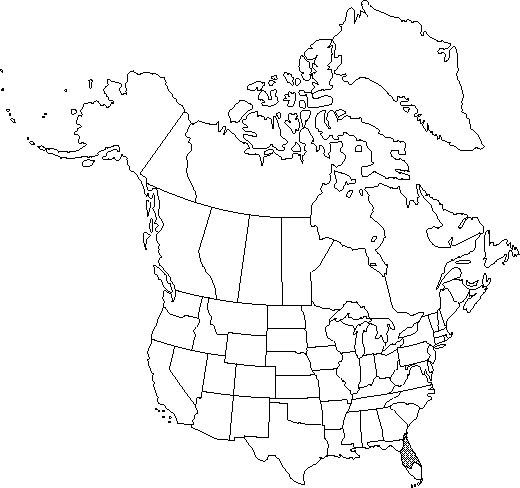Asimina pygmaea
Monogr. Anonac., 84, plate 10. 1817.
Shrubs, low, 2-3 (-5) dm. New shoots 1-several, sparingly branched or unbranched, arching, redbrown with sparse, appressed, red hairs, glabrate. Leaves: petiole 3-10mm. Leaf-blade ascending along and above shoots, obovate or oblanceolate, rarely linear-elliptic, 4-7 (-11) cm, leathery, base variously abruptly cuneate or narrowly rounded, margins revolute, apex rounded to obtuse or notched; surfaces abaxially and adaxially sparsely red-puberulent, glabrescent, abaxially pale, prominently reticulate. Inflorescences secund from axils of new shoot leaves, solitary flowers; peduncle slender, glabrate, 1.5-3 (-4) cm; bracteoles 1-2, basal or 1 suprabasal, lance-oblong, less than 1cm, hairy. Flowers maroon, fetid, large; sepals ovate, 5-10 mm, glabrate; outer petals maroon or pink with maroon streaks, oblong to ovatelanceolate, 1.5-3 cm, fleshy, margins revolute, apex spreading; inner petals erect, deep maroon, ovate-acute to lanceovate, 1/3-2/3 length of outer petals, fleshier, base saccate, apex excurved, corrugate zone adaxially deep purple; pistils 2-5. Berries yellow-green, 3-4 (-5) cm. Seeds shiny brown, ca. 1 cm.
Phenology: Flowering spring–early summer.
Habitat: Sandy peat of pine-palmetto flats, savannas, low sandy fields, and low sand ridges
Elevation: 0-100 m
Discussion
Asimina pygmaea hybridizes with A. longifolia var. longifolia and A. reticulata, with backcrosses introducing various heights, larger and variously paler flowers, and degrees of fragrance grading from fetid in the maroon types to progressively more fragrant in the larger-flowered swarm components.
Selected References
None.
Lower Taxa
"dm" is not declared as a valid unit of measurement for this property.

